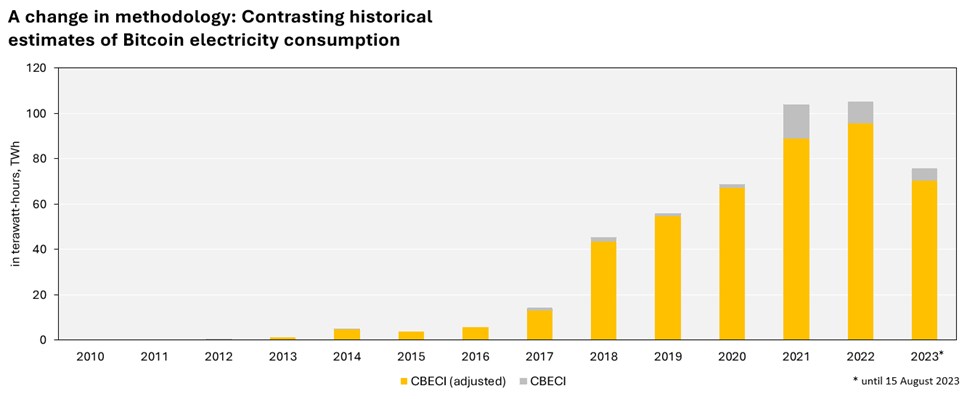Why Bitcoin mining may not be the power guzzler you think it is

- The revised annual estimate for Bitcoin mining in 2o21 was 14% less than the earlier estimate.
- CBECI indicated that the option of lowering carbon emissions estimates was also on the table.
Over the years, Bitcoin [BTC] mining has earned a lot of flak from environmentalists and crypto naysayers, who accuse it of being one of the most power-hungry industries and thus a major emitter of greenhouse gases.
Read Bitcoin’s [BTC] Price Prediction 2023-24
Bitcoin consumes less power
In this regard, Cambridge Bitcoin Electricity Consumption Index (CBECI) emerged as one of the most popular data portals tracking Bitcoin’s power demand and the associated environmental impact in real-time.
This data is frequently monitored by experts and participants from various industries in order to get actionable insights.
The research group recently revised its methodology used in measuring the king coin’s electricity consumption. Previous projections were significantly reduced as a result of the upgrade and its retroactive implementation.
According to CBECI, the models prior to 2021 were deemed reliable. However, starting from 2021, the inconsistencies began to surface. The revised annual estimate was 89.0 terawatt-hours (TWh), 14% less than the earlier estimate of 104.0 TWh.
Furthermore, th2 2022 estimate was reduced by 9.8 TWh, from 105.3 TWh to 95.5 TWh. Even for 2023, the estimate as of 15 August was cut down from 75.7 TWh to 70.4 TWh.
The revised figures were comparable to the electricity consumption of countries like Belgium and Netherlands, and tumble dryers in the U.S.
The reason behind the mismatch
The discrepancies emerged due to inaccurate tapping of mining hardware-related data, CBECI admitted,
“We found that more recently released equipment appeared to be underrepresented, and equipment nearing the end of its lifecycle was overrepresented.”
Over time, more efficient mining equipment has flooded the market, producing a higher hash rate per unit of electricity taken. As a result, a disproportionately large number of older devices in comparison to newer ones may dramatically alter the final power consumption figures.
The updated methodology highlighted the dramatic improvement in mining hardware efficiency. For 2021, the older figure of 74.2 joules per terahash (J/TH) was significantly greater than the revised model’s estimate 63.6 J/TH. The new model showed better efficiency in the subsequent years as well.
Is your portfolio green? Check out the BTC Profit Calculator
Will emission estimates fall as well?
To the delight of Bitcoin supporters, CBECI indicated that the option of lowering carbon emissions estimates was also on the table, as they wanted to factor in emerging concepts that were overlooked in prior studies.
At the time of writing, the network’s annual emissions were projected to be 57.26 MtCO2e, higher than that of countries like Chile and Burkina Faso.








![Sei [SEI]](https://ambcrypto.com/wp-content/uploads/2025/06/Gladys-13-400x240.webp)